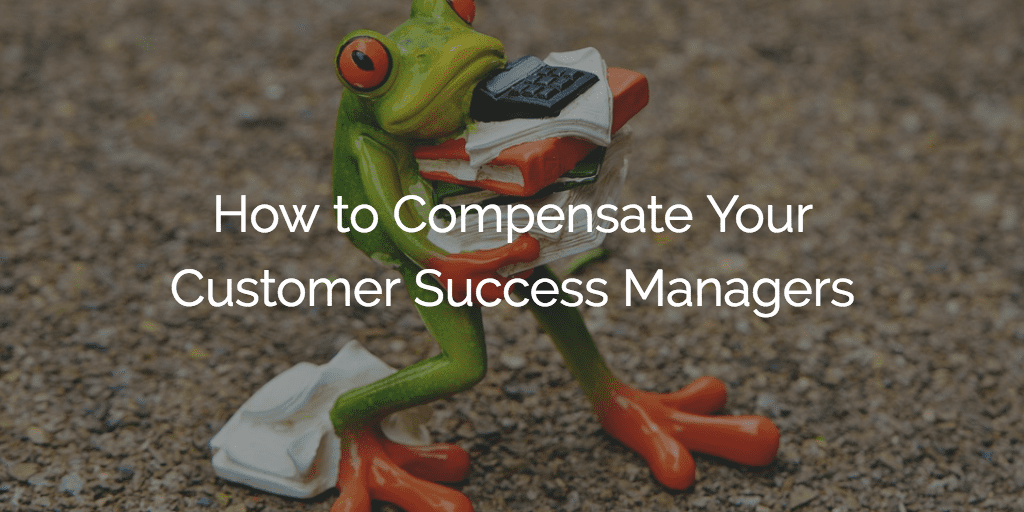This blog post is based on questions and answers showcased in our webinar, How to Budget for Customer Success: 2019.
Does a straw have one hole or two? Why doesn’t Tarzan have a beard? How do I compensate my CSMs? It’s questions like these that keep the world up at night. While the two former questions might forever be shrouded in mystery, we are able to provide some clarity on the latter. CSM compensation varies widely across companies, just as their job duties do. Luckily, our Chief Operating Officer, Allison Pickens, has worked with many different Customer Success orgs and shared her knowledge during our recent webinar on budgeting for Customer Success. Here are some best practices to keep in mind when building out compensation plans, creating incentives, and divvying up responsibilities for your CSMs.
Should Customer Success Managers (CSMs) “own” renewals with incentives and quotas?
“This is a hot topic and it’s been one ever since I can remember. The answer is: it depends.”
Every Customer Success has to adapt to their particular situation and business model. This means you have a lot of organizational structures to pick from. To make it easier on you, these can be boiled down to roughly three different models that can be used to handle the division of responsibilities between Sales and Customer Success. But no matter what, the executive that owns Customer Success should be responsible for the Gross Retention Rate (GRR). Why? Because all the activities that are being managed on that team should ensure a high and predictable GRR.

Variable compensation is standard practice in Sales, but when it comes to variable compensation for CSMs, do accelerators incentivize upsell/expansion efforts?
“I generally think this is a good idea for CSMs because variable comp, in general, helps to clarify what counts as success.”
At Gainsight, we use a variable compensation plan for our CSMs. These metrics make it easier to determine whether or not a CSM is victorious in their role as it gives them specific goals to hit. Creating a variable compensation plan for CSMs can be challenging because territories and accounts can range widely. For example, let’s say one of your CSMs is managing a high-risk account because you wanted to test out a new use case for your product. It would be unfair to penalize this CSM if the adoption curve isn’t as strong as a customer with a standard use case. Therefore, you may not want to impose a stringent curve on your team to allow for these experiments.
Should CSMs have expansion inform their bonus even if they aren’t driving the process or closing the deal?
“You want to make sure you preserve the “trusted advisor” status of CSMs. In order to do that, I’ve seen teams hold CSMs accountable by setting a team target goal and every CSM is working together with their peers towards that team target.”
If your business has a strong focus on “landing and expanding” (see Business Model #2 or #3 above), incentivizing CSMs with expansion-based bonuses can be a good idea. Even if the CSMs aren’t directly coordinating the transactions, they spend their day to day conducting activities that should be driving expansion and make the likelihood higher.
But just as you wouldn’t hire one type of salesperson, you wouldn’t hire just one type of CSM. Each member that you add onto your team has different strengths and skill sets. The reason why we point this out is that certain CSMs may respond positively (or negatively) to quotas. It’s important to keep a finger on the pulse of your team to ensure you’re motivating them in the best way possible.
How long does it take a CSM to ramp
The amount of time it takes for your CSMs to ramp is highly dependant upon the complexity of your product. If your product has significant breadth, it’ll take longer for a new CSM to ramp versus a simpler product. Best practices suggest that within three months, your CSMs should be operating autonomously, for the most part. If your product is quite simple, it should only take a couple weeks. Beyond understanding their basic job duties, CSMs should also become comfortable working cross-functionally within your company and should receive training to build this skillset.
When should you give your CSM a raise?
“Raises should be driven by improvement in a team member’s performance. Every quarter, you could review with a team member how they’re performing against that criteria. The idea of servant leadership is that you’re looking for opportunities for your team to grow and succeed because they’re benefiting themselves and your company. This way you’re helping them with this process.”
At Gainsight, CSM raises are primarily driven by two things: performance and compensation benchmarks. It’s recommended that you create a clear career path with different levels of CSMs and the criteria that you expect each level to have. Make your team aware of these expectations and work together to advance them up the ladder.
In certain markets, compensation is going up every year. Stay competitive and fair by annually benchmarking against the market and make adjustments when necessary. If the market rate has risen, it is in your best interest to help your team grow according to meet those new standards. Just like any fast-paced job, turnover is common in CSM. If you don’t compensate team members in line with the market, you heighten the risk that they find a better paying job elsewhere. Connect with your Finance team and partner together to find a way to stay competitive without breaking the bank.
What budgeting advice do you have for a company that is selling a complex product with limited internal resources?
It’s a tough spot to be in—you’ve got a complex product that requires a lot of work on the Customer Success side of things, but at the same time, you’ve got a limited supply of resources to work with. First, consider creating a Services offering that carves out aspects of the CSM role. This way, you can provide more help and value while keeping your team from getting burnt out. Over time, it might make more sense to outsource your Services team—especially if you’re preparing to go public and need to maintain a gross margin that services may detract from.
Second, reflect on the product and focus on how you can make it easier for the end user. If you make the product easier to adopt without the added help of the CSM, you give them time to spend on more critical projects. Last but not least, explore automation possibilities both within your product and within your CSM workflow. In the product, can you automate certain implementation processes? What about creating applications on top of your platform that addresses certain use cases? Building a small but capable customer engineering team to execute these initiatives can save you time and money in the long run. Concerning your CSM processes, they might benefit from an automated tech touch program that replaces human activities with in-app messages. Creating a rich content library with support materials and online tutorials can empower customers to be more autonomous and get up to speed independent of a CSM.
Never stop exploring
Every Customer Success organization does things slightly differently. This is one of the beautiful things about the discipline! So keep on asking questions, experimenting with new strategies, and discovering new ways to motivate and compensate your team. (And then share them with us at one of our many events 😉).

